Background
During the 1930’s, Swedish textile artist Aina Cederblom (1896–1986) set out on extensive solo boat journeys, logging distances that leave even today’s jet-engine-enabled traveler in awe. Merely covering distance however was not her goal, as she explained in a 1936 interview: “I want you to understand that there is very little love of adventure in my motor-boat exploits. It is purely for educational purposes.”
Cederblom’s “educational purposes” were anchored in her training as a textile designer at The School of Industrial Arts in Sweden. During her travels she often paused to teach women to weave and, when possible, established weaving centers and schools. Left in her wake were many gainfully employed women with self-sustaining skills who subsequently preserved their own national textile traditions.
The Travel Adventures: 1931–1938
Normally we interview our subjects but in this case we could only speak to those who knew her or read about her in documents (mostly translated from Swedish). What we have gathered from all accounts is that Cederblom was a physically small but constitutionally mighty woman who combined weaving, teaching and humanitarian aid with an itch to travel. She made three major solo journeys across Europe, to the Black Sea to Greenland and the Far East before dedicating her life to humanitarian projects.
Trip 1: Europe 1931-1932
Her first trip in her open motorboat, Rospiggen, was sparsely equipped: “two thin blankets, a pillow stuffed with hay, a thick cloak to sleep in and a raincoat.” The few other items on board included a picnic basket, a gas can and a set of oars. The 34-year old Swede was a bit naïve about the demands of long-distance boating; on her first journey she had no compass or charts, just a road map. Fiercely determined to sail alone as much as possible, she would “hitch-hike” (or freight) her boat as cargo to reach difficult locations and then would then resume her journey aboard the Rospiggen.
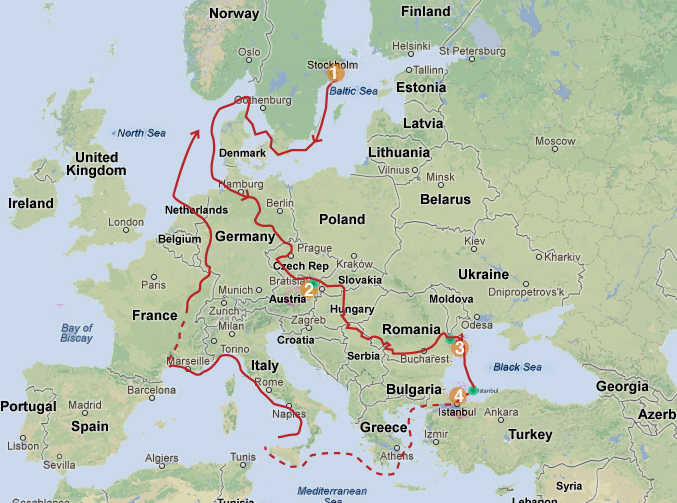
Traveling down the Elbe and then the Danube, the first leg of the trip went as far as the Austrian city of Pöchlarn (near Vienna) where Rospiggen would be put up out of ice. Cederblom spent the winter teaching weaving to local women before setting out for the Black Sea. (See Epilogue below). Her course was outlined in a newspaper item (with some small errors) on July 5, 1932 in The Long Island Star: “Stockholm: Piloting a small boat with an outboard motor from Sweden to the Black Sea, Miss Aina Cederblom of this city has arrived in Constanta, Turkey.” (Note: It was likely Constanta, Romania). “She took her craft via the Baltic Sea, the North Sea and the Atlantic Ocean through the rivers of Central Europe. She intends to proceed to Istanbul and later to visit the large European and African ports around the Mediterranean.”
The long and arduous trip included some seriously close calls: running out of fuel, engine trouble, unfriendly Hungarian border guards and gunfire on the border between Romania and Bulgaria. (It was a time when passports had to be shown at all borders.) One encounter with severe weather was posted in The New York Times on August 3, 1932: “A remarkable feat of endurance by a Swedish girl of Viking strain, Aina Cederblom, in a tempest on the way from Nice to Calvi. Her small boat Rospiggen shipped water and the engine failed. She rowed 30 hours until the boat was taken in by a steamer thirty miles from Nice.” The rest of the trip was off of the open seas, via the Rhone past Avignon and then a train ride to Strasburg before heading downstream on the Rhine to the North Sea through the Kiel Canal, Gothenburg, Gota Canal and finally back to Stockholm.

Trip 2: Greenland and the American Continent
On her second trip Cederblom planned to “hitch-hike” her new 15-foot Rospiggen II through the islands of the north Atlantic. Starting in Norway she made her way to the Shetland Islands, along the way suffering in strong seas that required she stay awake for 30 hours. She shipped out from the port of Lerwick and again encountered rough seas. Once in the Faeroe Islands she learned of a Danish ban against passengers traveling from the Faeroe Islands to Greenland, so she arranged to sail far out into international waters and then board a Danish fishing boat. Ignoring predictions that she would never see the American continent, Cederblom and her boat were then dropped off near the coast of Greenland equipped with 100 gallons of fuel, water, 30 sea biscuits and a fur coat.
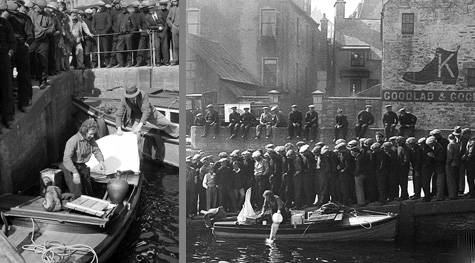
Unfortunately, before she reached the shore her boat became locked inside of an ice floe where the whirlpools from shifting icebergs required her, at one stretch, to row for 24 hours straight to escape being sucked into ice caves. Accompanied by penguins, walrus and seals for 19 days she rationed herself to one biscuit every other day and limited her water intake until she was finally able to break free. “My knees were shaking, I thought of what they told me, that I should ‘never see America’ but I learned that you cannot be afraid and at the same time hear the direction that God gives. I prayed to be shown how to get out of this ice room, finally started my engine and ran it among the small ice, parting it, time and time again until there was finally an opening visible through which to go out.”
She was picked up 2 miles from Greenland’s shore, where upon arrival she “wanted to lay my face against the land, loving even the smallest flower.” The authorities immediately returned the law-breaking sailor to Denmark. After a short stay back at home in Sweden she returned to the Faeroe islands and set up her first weaving school, staying for one year to instruct the island women— providing them a means of income and preserving the local textile tradition.
Trip 3: The Far East (Sri Lanka, India, Tibet, Vietnam, Cambodia, Java, Sumatra, Bali, Borneo and the Phillipines
By the time she traveled to the Far East, Cederblom was much better prepared. Her Rospiggen III measured 18 feet in length, had steel reinforcements, an Albion motor and large amounts of fuel in copper tanks. On October 17, 1935 the Singapore Free Press reported on Cederblom’s progress: “having rested in Ceylon for 5 weeks Ms. Cederblom is now ready to begin her position as weaving mistress at Dr. Rabindranath Tagore‘s school ”at Santiniketan (near Calcutta) India. (Dr. Tagore had created an “authentic” curriculum that emphasized skills and crafts critical for the lives of students growing up in rural India, including how to weave scarves, belts and rugs, duree making as well as building looms out of bamboo. Tagore’s educational philosophy dovetailed with Cederblom’s background in Educational Sloyd—crafts as an essential element of education.)
The reporter asked her why she spent her nights on the boat. “I wanted to see what a tropical night was like,” she replied, “Besides don’t you think it is thrilling? I was amazed at the spectacle greeting me upon rising this morning. The many fishing smacks, setting out, provided a gorgeous site…”
Having first sailed by steamer to Colombo, Ceylon (now Sri Lanka), she traveled up the coast of India until, running short on time, went ashore in Vizagapatam to finish the trip to Calcutta by train.
After a year of teaching Cederblom traveled to the Himalayas and Madras. A record of her attempts to reach the forbidden Tibetan city of Lhasa is included in Peter Hopkirk’s book, Trespassers on the Roof of the World: The Secret Exploration of Tibet. Hoping to fool the border guards she dressed as a Tibetan and slept in servant’s quarters. She was exposed and escorted out of Tibet to Darjeeling by a doctor whom she tried to persuade to take her to Lhasa as his “cook/companion.” He declined although he described Aina as “perfectly charming.”
There were perils on this trip as well. She was hit by a fishing boat, a river tidal wave, wood-eating beetles and blistering under the tropical sun. It is on this trip (we have heard) that Cederblom had a serious tooth infection that was not properly cured and later corrective surgery left her face permanently disfigured. This does not seem to have deterred her from continuing her rigorous life.

Back in Sweden Cederblom was becoming known from her books, With Outboard Motor Through Europe and A Sea Vagabond on the Atlantic. Her travel exploits were featured in major magazines, international newspapers and newsreel interviews, but her greatest achievements were to come as a humanitarian.
1941-1986 / Humanitarian Projects in Finland and South America
In 1940’s she came to the aid of people in the West Uusimaa archipelago of Finland who were fleeing the Russian occupation after the 1939 Winter War. She helped evacuate the Finns to Tammisaari (Ekenäs), providing the dislocated families with pre-fab homes and supplies that she hauled from Sweden on an old trawler named Brill. She personally sailed the twelve-hour trip from Stockholm to the outer Finnish islands through waters that were partly mined, enduring several engine breaks and oblivious to the two reports that were issued that she was missing. Hailed as a hero in Finland, Aina made five trips during the summer and autumn of 1940 and organized a feeding station for over 500 children in Helsinki during Second World War from 1941-1944.
In the post-war peacetime her focus turned to the needs of the elderly Finns. With a goal of building a retirement home in Porvoo (near Helsinki) she established a weaving center to train women in the hand production of rugs and upholstery fabric. Cederblom then devised a rather unorthodox trade deal in which she packed the woven goods from her Finnish students and hopped a freighter to Argentina. Once there she sold all of the rugs and woven goods, immediately purchased 25 tons of rice from Paraguay (to assure the value of her Argentine pesos in an economically volatile time). The rice was shipped back to sell in Finland to low income families at cheap prices. This successful venture was repeated three times before the Paraguayans demanded American dollars instead of Argentine pesos: and for that purpose she began traveling to the US in 1952 to sell to the American market.

Near the end of her life Cederblom settled in Brazil and established the Escola Artesanal Sueca Brasi, a weaving school and mission in Olinda, in the northeastern part of the country. This time the funds came from her Swedish social security and a $6,000 compensation that she received after being hit by a car during a visit to the US. Using her meager funds and salvaged building parts from buildings demolished in Sweden was still not enough to finish her project, so she turned to the Swedish Lions club for financial aid. The weaving center and school, Escola Artesanal Sueca Brasi Liera, was completed in 1970.

In 1980 her life story was featured on the Swedish Television series Here is Your Life and if you speak Swedish, you will find more about her here. Cederblom died in 1986, known mostly inside her own country where she is remembered in songs, theatrical plays and on streets that carry her name. Someone has also put up a Facebook page about her.
**Epilogue: Lisl’s Remembrance of Aina (This section especially for Liesl’s children, grandchildren, great-grandchildren, nieces and nephews)
We first learned of Cederblom during the fall of 2012 from 88-year old Aunt Lisl who wove professionally for 60 years after getting her start with the Swedish weaver. This is how Lisle tells her story:
In 1932 Aina Cederblom arrived in Shiebbs, Austria (outside Vienna) at the home of her friend, Martha Thonet, and spent the winter teaching her hostess how to weave. Others who benefited from Cederbloom’s instruction were Martha’s sister, Hermine, and niece Liesl (Aunt Lisl) who lived on the grounds of the Thonet’s Villa Lehenhof.
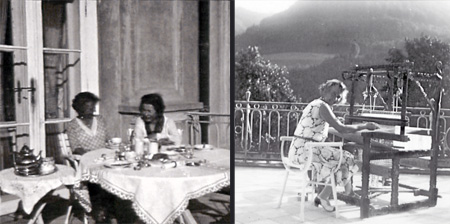
For Lisl and her family (name, Roessler) weaving would become more than a pastime, it was a skill that would sustain them before and after the coming war. During the hard economic times of the 1930’s Liesl, her mother and younger sister Friedl, wove fine shirt fabric to sell to tailors in Vienna. In 1945 the Roessler’s fled the invading Russians to the Austrian mountain village of Kitzbühel to regroup and wait for the end of the war. During that period Lisl developed a unique design style, Bauern Baroque (Farmhouse Baroque), integrating traditional Austrian motifs. The women wove enough rugs, placemats and pillowcases to sell door-to-door until a permanent weaving business could be established back in Salzburg when the war ended. Friedl married an American soldier and moved to the US. Lisl, Hermine and youngest sister, Johanna continued on as full-time weavers.
Johanna later opened a custom design clothing store in Kitzbuhl and raised a daughter, Kathi Roth, now a psychiatrist.
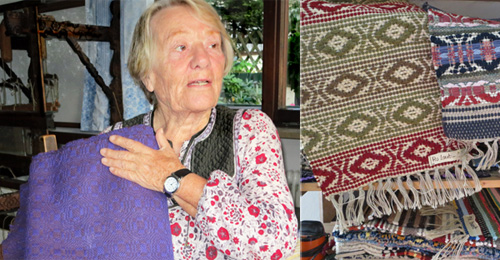
Eventually Lisl also married and moved away, weaving alone in her new location until her daughter, Christl, was old enough to join her. (Her son Marcus, did not weave.) Mother and daughter sold their weaving from a storefront in their village, Golling an der Salzach, and later from their large weaving studio and home built into a nearby hillside. Local women were hired and trained to produce large carpets and smaller woven accessories in one of the few traditional weaving studios that remained in Austria.

Christl traveled to Vienna for rigorous commercial training under the weaving master Heinrich Hetzer. She had her own family of three children who grew up around the looms of the family business but the tradition of weaving will not continue. (The fourth generation have chosen web design, graphic design and management as their paths.) Christl remains the sole active weaver in the family, proprietress of Handweberei Christl Seiwald-Buxbaum in Golling an der Salzach.

The Roessler women saw Aina a few times later in their lives. During the 1950’s Aina visited Freidl in the US, most likely during her selling-rugs-for-rice scheme. Lisl and Christl recall seeing her in Austria but the details of the dates are sketchy. They note that she traveled with a very large steamer-type trunk that contained her clothing and doubled as her place to sleep. (It was probably a necessity since by then she often traveled by slow commercial freighters). There was always plenty of laughing and lively conversation when Cederblom visited. What remains is a warm gratitude to Cederblom for passing along a skill that sustained the family through the decades of hard and happy times.
Additional Sources:
Many thanks for Andreas Maleta for confirming Cederbloom’s name in the 1932 guest book from Villa Lehenhof and providing the photographs of Martha Thonet with Aina Cederblom.
Swedish Girl’s Lone Voyage, The Singapore Free Press and Mercantile Advertiser, 17 October, 1935, page 12.
Jesse Ash Arndt, Fearless Enterprise Aids Quiet Swedish Woman’s Program of Helpfulness, The Christian Science Monitor, January 17, 1952.
This Is Your Life on Swedish Television. Lasse Holmqvist, host. Aired Saturday, 25 January, 1980.
Tapti Das-Gupta, Social Thought of Rabindranath Tagore : A Historical Analysis, Abhinav Publications, Jan 1, 1993
Aina Cederblom, Världshavens äventyrerska, Enslinjen, Ekenas Navigationsklubb, r.f, Nr 21, 2010.
This entry written by Nancy Stock-Allen in memory of Deborah Warner (1948-2012), textile artist, beloved professor, colleague and friend.
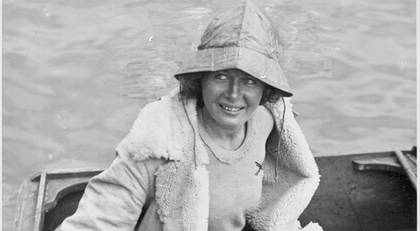
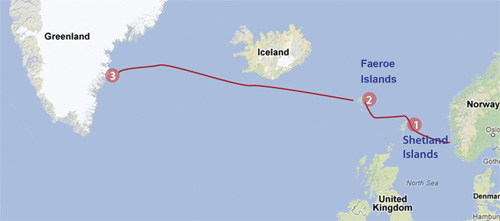

2 thoughts on “Swedish Weaver, Teacher, Traveler and Humanitarian: Aina Cederblom”